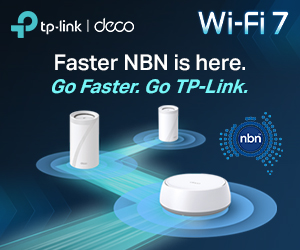The new Telstra Smart Modem 4 is Wi-Fi 7 and 5G fallback capable, but this is simply marketing hype that covers up the fact that this is still a very crappy modem router.
We will update this as we get more information. The CyberShack community is working.
Update: 28/8/25
Reader Will has disassembled his and advises
- Sagemcom Model FAST 5988TA V2.1 (no results on Search)
- 1x Quectel RG650V-TL (4/5G)
- 2x Qualcomm QFW7114 (No details on search – likely the CPU and Wi-Fi chip)
- 1x REALTEK RTL8367S (4-port 100/1000 Switch)
- 4 x internal Wi-Fi antennas connected with u.fl connectors on the motherboard (This means 2 x 2.4 GHz and 2 x 5 GHz, which have to support Wi-Fi Rx/Tx and mesh satellite forward and back haul).
- 2 x internal LTE antennas on the PCB, with external u.fl’s to SMA connectors on the back of the case. There was an ‘internal’ or ‘external’ antenna option in the settings.
- 1x WAN (magnetics: G24107MN-R) Confirmed as 100/1000
- 4x LAN (magnetics: GST5009BM) Confirmed as 100/1000
- Full teardown here.
Update: 30/8/25 – Huge issues with WPA3 – have to disable Wi-Fi 7
Reader Jeff writes that older WiFi devices that use WPA2 or WPA (not WPA3) require the modem to be crippled. After hours of trial and error, and Telstra support:
- Wi-Fi settings
- Turn Wi-Fi 7 → OFF
- Change Wi-Fi mode → Wi-Fi 6 (2.4/5 GHz)
- Set channel bandwidth → 20 MHz (not 20/40 MHz)
- Disable Band Steering (no MLO backhaul)
- Separate Wi-Fi bands
- Rename 2.4 GHz and 5 GHz Wi-Fi so they have distinct names (e.g. HomeWiFi_2.4 and HomeWiFi_5)
- Connect devices
- Printer must connect only to the 2.4 GHz Wi-Fi
- Other devices (such as iPhone, iPad, and computer) must also be on 2.4 GHz when printing.
This effectively makes the SM4 slower than the SM3!
What is wrong with the Telstra Smart Modem 4?
Way too much. For starters, its performance is no better than a Wi-Fi 6 modem, and it does not have a 6 GHz band. WTF?
It is big
25cm (L) x 6cm (W) x 19cm (H)


Telstra can remotely disable it
Reddit has reported that it can be remotely disabled for non-payment.
Telstra refuses to reveal the BE speed
Most modem manufacturers quote a speed, in this case BE, and a number. We suspect it is BE3600 or 2.4 GHz 688Mbps and 5 GHz 2882Mbps. This is really slow.
Even if it’s BE5000, it only gives you 5 GHz 4324 Mbps, of which half is dedicated to satellite backhaul.
It is dual band – 2.4 and 5 GHz – no 6 GHz at all
Wi-Fi 7 is all about tri-band – 2.4, 5 and 6 GHz. Without three bands, much of the go-fast Wi-Fi 7 technology is limited.
If you Disable Bandsteering, you disable Wi-Fi 7 features
If you want to have a separate 2.4 GHz and 5 GHz SSIDs (necessary for a lot of IoT devices), it disables Wi-FI 7 ‘go-fast’ features, including MLO. This can have a terrible impact on Wi-Fi backhaul.

It does not support 320 MHz bandwidth.
- 2.4 GHz band has 10/20/40 MHz bands for a maximum connect speed of 466 Mbps
- 5 GHz band has up to 160 MHz for a maximum connect speed of 2402 Mbps
- It has 1024 QAM, not Wi-Fi 7 4K-QAM.
Wi-Fi 7 can connect at 5804 Mbps (6 GHz 320 MHz), but not this modem!
It has a 10/100/1000 Mbps WAN port
It won’t support the new NBN speeds over 1000 Mbps. Where is the future-proof 2.5, 5 or 10Gbps WAN port?
It has 4 x 10/100/1000 Mbps LAN ports
It won’t support 2.5, 5 or 10 Gbps Ethernet backhaul, which is really important for mesh and Wi-Fi hogs!
Only USB 2.0 – Why not USB 3.0 5Gbps?
This is a pathetically slow 480Mbps (60 MBps) half-duplex, so the maximum speed you can get is about 30 MBps for file sharing.
Wi-Fi mesh is pathetic
We don’t have any details on whether there will be a new Smart Booster 4, but any mesh over dual-band will result in slow and unreliable performance. To be clear, it will take about half the 5 GHz bandwidth for satellite backhaul, leaving little for your Wi-Fi devices.
5G fall back – a farce
So few users get a strong enough 5G signal that, for most of the time, the modem will be hunting for 4G band 28 or Band 3. The maximum speed, regardless, is 25/5Mbps. They put in an eSIM capability so that they don’t have to report to the ACCC the frequency of hardware outages – you still have some Internet access.
But Telstra don’t tell you that most of the time you can’t get a 5G signal indoors and very poor 4G signals at best. It has dual external SMA antenna ports, but the cheapest Telstra-certified dual-band 4/5G antenna is around $500 plus cabling and fitting!
It is made by Sagemcon in China
It is a Mongoose-5GFW, but don’t look for that model name as Telstra makes it up. We were informed that Technicolour made it, but a reader says it is Sagemcom. Its pedigree is not so important as the model number. Now confirmed as Sagemcom F@ST 5988TA V2.1
Note: It is not the Sagemcom F@ST 3897T as suggested on Whirlpool. Model details to come.
In our experience, the Telstra Smart Modem 3 – not all that smart or fast (update after test – network review) accounted for the majority of dropouts, which magically stopped by replacing it with a better modem.
Telstra still uses a proprietary voice protocol, so you can’t use this modem for a landline on another NBN network.
Designed for all types of Internet
It supports Ethernet and VDSL WAN types. The Quad-core ARM Cortex-A55, 2.2GHz processor is adequate, but it is pretty limited with 2GB LPDDR4 RAM. This is not for heavy users or gamers.
The claim that it supports up to 250 Wi-Fi devices is laughable
Telstra is simply quoting the IP range, which is 1 to 256, in a subnet.
Assuming these were primarily 2.4 GHz IoT devices, you may get 30-50 active devices. Far less so if you have Wi-Fi security cameras and video doorbells that need closer to 5 Mbps for HD and 25 Mbps for 4K. Add in a Wi-Fi speaker system and a couple of 4K TVs for streaming, and it is closer to 10 active devices. To be fair, Telstra is quoting ‘up to’.
FAQ
There is no downloadable manual.
FAQs are very limited.
Cost – not worth it
You can buy it outright for $240 or $20 or $10 per month on 12- or 24-month plans. Existing Smart Modem users are not offered a free upgrade.
Yes, it has 4/5G fallback, works on FTTN and FTTC and has a proprietary voice port, but it is not Wi-Fi 7 tri-band. It does not have a DECT chip for handset connections.
CyberShack’s view: Telstra Smart Modem 4 is the quintessential crappy NBN modem
I can’t understand why Telstra persists in lying by omission. If it revealed its true specs, consumers would have a choice. But no – it wants to lock you into expensive NBN and crappy hardware.
Even if you are a rusted-on Telstra user and have an Ethernet NBN connection, I can think of several lower-cost routers that would eat this for breakfast. Look at the TP-Link Deco mesh BE65 or BE65 Pro Wi-Fi 7 tri-band 2.4/5/6 GHz BE11000 (three times as fast), seen as low as $368!
Whatever you do, there are far better and lower-cost NBN providers and hardware out there.
Read
- Got a Wi-Fi problem but not much cash to fix it?
- NBN switching – tired of Telstra, Optus and Vodafone?
- Seamless whole-of-home Wi-Fi is easy with Wi-Fi 6/6E/7 (2025 update network guide)
- Crappy NBN Modem – here are a few better ones (2025 update network guide)
Telstra Smart Modem 4 , Telstra Smart Modem 4 , Telstra Smart Modem 4










34 comments
John McKay
I have been with Telstra for over 11 years. I had the upgrade from ADSL to NBN fttn. I got the Tsm2 which was rubbish. When they brought out the 3, I asked for the upgrade to it and they refused. I bought the Tsm3 and the booster. I am on the 100 NBN plan and have always had full speed downloads. Last month I changed to Telstra 5G internet, at first I had speeds reaching up to 400Mbbs. There was however a problem as my 2.4 ghz security camera and video doorbell would not connect. Telstra support went through the setting that I had to change in the modem. The ones you have highlighted. This sorted my devices connection problem, accept my internet speeds dropped back to100Mbps. I also had to give up my home phone connection with the Tsm4, so I went back to the NBN and the Tsm3.
Ray Shaw
The SM4 mandates WPA3 but you can downgrade it to SM3 specs by turniong off beand steering and setting up separate 2.4 and 5 GHz bands. The 2.4 GHz camera issue is well known and requires you to set up a dedicated 2.4 GHz with WPA2 encryption (or earlier).
John McKay
Yes I did all of the above but that slows down the speed to the modem, which defeats the point of having the 5G internet
Ray Shaw
All I can suggest is that you use the 5G as a router and connect the SM3 WAN to LAN as the main router. No need to bridge as lon as you have a separate SSID. Sorry, but I don’t know enough about the SM4 5G version to help.
Geoff Lee
Hi Guys, I recently received the SM4 – moving up from SM3 which has been good. I have FTTP 500/50 plan. Using the SM3 I get 542.57 Mbps Upload and 47.3 Mbps Upload. Changing over to the SM4 I get 413.61 Mbps Download and 0.10 Mbps upload which is an issue. Please note that this relates to a wifi connection from the SM4 modem to my PC which is only a couple of years old. Same happens with my laptop. NBN was put in our bedroom and I will be getting cables put in which will solve the problem but I would be in trouble if I have to rely on a wireless connection all of the time. After repeated and long conversations with Telstra and providing with screen shots of the speed tests from both modems, they finally agreed to let me pick up a new modem from the local Telstra shop. Plugged in NO change. SM4 has the same slow upload of around 0.10 Mbps. I’m now back to my SM3 with good download & upload speeds. Can it be an issue in the modem settings. I’m not an expert and it is frustrating. Is anyone else having this type of issue. Cheers
Ray Shaw
Hi Geoff
Please read https://cybershack.com.au/smart-home/free-nbn-speed-upgrade-has-arrived-but-youre-not-getting-it/ and try the suggested way to measure the internet speed. At least that will determine if its Wi-Fi to your PC, the SM4 or something else.
Read https://cybershack.com.au/smart-home/free-nbn-speed-upgrade-modem-mayhem-is-just-a-scare-tactic-to-sell-more/ and I will sneak you in to our free advice, which ends 30 September (see the end of the article for what I need)
Ray
Mike Lazarus
I just got one and have a couple of corrections and some extra issues:
1. I have WPA2 devices without disabling WiFi7.
2. According to the Settings > Device info, the WAN is listed as 2.5Gbps. Though the LAN ports seem to be 1Gbps.
3. The LAN ports are too close together for some cables to sit next to each other.
4. If using a local DHCP server on your LAN, you can’t see any connected Ethernet devices or the names of the Wi-Fi devices.
I would love a suggestion for a better router that also has 5G backup that works with Telstra
Mike Lazarus
Re 2: It says 2.5Gbits, but is still only 1Gbits
Ray Shaw
Thanks, Mike – that is what the CyberShack Community is all about.
Ray Shaw
If you have FTTP or HFC, Bigpond, want 4/5G backup (25/5Mbps) and have a landline, you are stuck with the SM4. The discussion over 2.5Gbps was settled when a reader did a teardown, and the WAN/LAN chip is only 1Gbps. I think you will find that WPA2 does disable Wi-Fi 7 ‘smarts’ (WPA3 is mandatory for the 6GHz band), but as it’s only dual-band, that does not matter. I have yet to see one in the flesh to do a full review, so nothing surprises me.
Mike Lazarus
Windows sees it as WPA3, but the Fetch box only has WPA2. Both seem to connect without issue.
I don’t have or need a landline, but would like the backup… Would that still be the same issue?
Ray Shaw
Hi Mike
As I don’t have one to test, all I can say is that if you select dual band 2.4 and 5Ghz then in theory both bands should accept WPA2. If you use MLO (single SSID) you are úsually’stuck with WPA3. Here is the standard: Using the 6 GHz band with Wi-Fi 7 or Wi-Fi 6E requires WPA3 security, with devices and access points needing to support it to connect to that band. Wi-Fi 7 also mandates WPA3 support across all its bands (2.4 GHz, 5 GHz, and 6 GHz) for full feature certification. If your network is not configured for WPA3, devices won’t be able to detect or connect to the 6 GHz band, even if they are Wi-Fi 7 or 6E compatible
Lee Graham
I hope I’m allowed to respectfully disagree with you. I’m certainly not idealising Telstra (too expensive, better tech needed etc) but it’s important to share the whole story. I’ve been with Telstra for decades and have found them to be very reliable. And my Gen 2 and Gen 3 modems have been excellent on FTTN. Very consistent speeds and on the very rare occasions of the network being down, 4G backup has worked great. In saying that, once I get FTTP, I may move to Aussie Broadband or similar but their prices are not much different, to be honest. We’ve run a business from home since dial up days and Telstra have been great. I’d give them 8/10. Not perfect, sometimes frustrating – but generally very good.
Ray Shaw
I love it when people respectfully disagree – it is what makes the CyberShack community so valuable. The original, Gen 1, Gen 2 and to a lesser extent, the Gen 3 were products of the time. We had a horrible, pathetic, frustrating experience with FTTN (NBN resold via Telstra), which ended up costing them a considerable TIO fine, and they had to refund my entire use of NBN from 2017 to 2021. The issues were ‘stacked’, causing a perfect storm. The base issue was that Telstra’s old copper was unreliable. Rain, bad weather, or whatever made it drop out several times a day. The second issue was that the Telstra modem lacked the 35b advanced error correction, so if a VDSL signal was weak or varied, it dropped out. The third issue was that we had 13 Tracert hops from the Central Coast to Telstra Sydney (Aussie BB has 3), and Telstra’s overlays on the NBN River were inefficient and designed to route traffic via the least cost to them. I lost count of the number of new modems sent (at least seven), we had to replace the wiring from the external FTTN termination (at our expense), which the TIO then made Telstra pay for. Long story short, I had been a rusted-on Telstra user since its GPO days, and my blood pressure could not take their ineptitude anymore. I heard good things about Aussie and gave them the gory back story. Within minutes of swapping and installing a D-Link 35b FTTN modem, I was getting 120Mb/20 from a 100Mbps line! It was reasonably reliable until we got FTTP a few months ago. But the story does not stop there. My neighbours had a Gen 3 and were also having major issues. Swap to Aussie and a D-Link modem – all fixed and one outage in 6 months with a D-Link M60 mesh. The story repeats at over a dozen homes I have consulted at. My tome is my story, and I am really glad that you have had a better experience. Einsteins definition of insanity is doing the same thing and expecting a differejnt result. Someone should tell Telstra that.
Andy Rothman
Qoute – “Wi-Fi 7 is all about tri-band – 2.4, 5 and 6 GHz. Without three bands, much of the go-fast Wi-Fi 7 technology is limited.”
Not 100% true. 6GHz was available on Wi-Fi 6e.
Dont get me wrong, Telstra and Sagemcom have catastrophically missed the mark when developing this product! Both organisation have been developing product in Australia for some time. (Sagemcom did all the Optus modems looking at Whirlpool)
Wi-Fi 7 main benefits is MLO and 4K QAM.
What I am perplexed about is how both the Telstra and Sagemcom teams have missed some of the most basic test cases for Wi-Fi compatibility.
Ray Shaw
Hi Andy – you are correct about 6Ghz on Wi-Fi 6E, but it was always a standalone band, no MLO aggregation, 1024 QAM and most router makers skipped 6E because 7 was coming and better. The short answer is that Telstra wanted a cheap modem that would work for FTTP, HFC, FTTN, FTTC, and even 4/5G internet. They got just that – a crippled dual-band that most people will have to run as Wi-FI 6 to support older WPA2 devices. It did not think through the massive issues with mesh (we have larger homes here), and I note that it is still using the Booster 3 that uses over half the 5Ghz bandwidth, making it no better than an AX1600 router.
Will
Better late than never!
https://github.com/Will-WD/Telstra_Smart_Modem_4_Teardown
Here are some internal pics & speed tests:
I had a Sierra XR80 and standard sim in the location already. I was getting around ~200Mbps.
Swapped to the TSM4 because the existing sim data plan I had capped out at 400GB/month. Telstra don’t offer the 1000GB/month plan with the standard data only sim. Speed tests result in around ~300-400Mbps.
You need to be locked into the TSM4 ‘home 5G’ plan which couples the data & modem with internal esim.
I have 2 external window mount paddles mounted on the window and the LTE antenna settings set as ‘auto’ so it should jump between internal & external antennas. Speed so far seems fine, WIFI load is a 1/2 dozen devices in a small area so not really worried about the WIFI specs.
If the TSM4 turns out to be a pile of garbage and Telstra push through updates to it or it’s constantly overheating, I’ll look at removing the esim from the motherboard & installing it in a MFF2 -> Sim carrier & pop it back in the Sierra XR80. Only time will tell I guess.
Cheers, Will
Ray Shaw
You are a marvel. I will add the link to the article. CyberShack readers can’t thank you enough. If you get time can you post the UI screen shots.
Garry Mitchell
If as Telstra claim, it’s so good, why not offer a free upgrade to existing customers, are they worried that with the rubbish speed I currently have, and being told by Customer Service that the only other plan I can get is slower than this one, so this modem would slow me down even more?
Ray Shaw
Gary, I long ago divorced Telstra because of its non-existent service, lousy offshore call centre, billing errors, stupid mistakes and premium pricing! Yes, by leaving, you lose your Big Puddle email address (you can keep it for 12 months for free), but you gain incredibly good NBN suppliers like Aussie Broadband and can take your landline phone number with you. Once you are free of Telstra you can look at routers that will give you whole-of-home coverage. If you need help, contact me at [email protected]
Paul Robertson
Hi, I have a question (I’m a Telstra Customer and have the Gen 3 Modem) regarding if I buy one of the Modems you recommend instead of the Telstra one, can I still use my Landline and same phone number? I have FTTP on a 100gb plan. The numbers that are talked about in your article and comments are all a bit confusing, I’m fairly Tech savvy for a 70 odd person but all those number, ohh dear! I look forward to your reply, thanks, Paul R.
Ray Shaw
Hi Paul
Telstra won’t reveal its proprietary VoIP settings, so you are stuck with using its modem as a VoIP device to plug a landline into. However, there is excellent news: you can unplug the SM3, plug a new mesh router’s WAN port into the NBN Ethernet UNI-DI port, and then plug the Telstra SM3 into a LAN port on the router. UNI-DI> Ethernet cable>new router WAN>Ethernet LAN to SM3 WAN. The real issue is what you need for whole-of-home coverage. If you contact me at [email protected], I can recommend what you need. We dont sell anything, pass on leads – we are safe and have heled 100s of readers.
Paul
Thanks for your prompt reply, it sounds all a bit complicated but I will email you.
stephen edwards
I know this isnt the right platform to complain but i am a customer of 21 years with iprimus i recently asked to upgrade my nbn plan up to nbn 100 , they upgrade my plan to nbn95 in anticipation of the nbn speed upgrade in September,which primus say they havent heard anything about the upgrade ,that was 3 weeks ago and 6 contacts with there tech dept speed is ok by ookla speed test but i now have No volp phone just a continuous engaged signal cant recieve calls or ring out the suggested i upgrade modem from hg569 to a KAON DG2144 At my expense with i have done still no satisfaction with Volp, after reading whirlpool reviews Volp seems to be a common issue with iprimus any other suggestions would be greatly appreiciated.
Ray Shaw
Hi Stephen
I am not familiar with iPrimus, but Whirlpool is littered with complaints as they won’t reveal the VoIP settings or password – it all has to be remotely configured. It is a way to lock you into iPrimus.
1) Insist that iPrimum get VoIP working – no excuses
2) If not, go to Aussie Broadband, and they can get you up and running in minutes using your KAON crap router. It may need a reset and new settings that you enter with full help from Aussie’s Australian call centre.
3) Consider your whole-of-home Wi-Fi needs because the KAON will only cover a few immediately adjacent rooms. Read https://cybershack.com.au/smart-home/got-a-wi-fi-problem-but-not-much-cash-to-fix-it/ and fee free to ask me for advice at [email protected]
Will
I just received one of these units today to use as a 5G router for my mum, very low load & small house so it will be fine, but I accepted it with gritted teeth. I opened it up to see what was inside. I’ll upload some pics to reddit tomorrow.
It’s a Sagemcom FAST 5988TA V2.1
1x Quectel RG650V-TL
2x Qualcomm QFW7114
1x REALTEK RTL8367S
4x internal WIFI antennas connected with u.fl connectors on the motherboard.
2x internal LTE antennas on the PCB, with external u.fl’s to SMA connectors on the back of the case. There was an ‘internal’ or ‘external’ antenna option in the settings. Which makes sense.
1x WAN (magnetics: G24107MN-R)
4x LAN (magnetics:
Ray Shaw
Thanks, Will – your help is just what we need. The key issue is the speed at which you can connect in 2.4GHz and 5GHz (Bandsteer off).
Chris Smith
Great to seeing this reviewed but I do think you’re missing the key point of this modem. It’s made for people who neither understand or care about the technology and just need to pipe NBN 500 or whatever speed plan they’re on around their house. For that task, it’s plenty capable. There’s no point adding dedicated mesh backhaul, 6Ghz or wide channels when you’re only pushing 500Mbps down the NBN pipe.
Also, MLO and 6Ghz has a dirty secret – it’s really power hungry. Handset makers want to preserve their battery life so they only activate MLO and 6Ghz when it’s really needed, and that’s almost never. Your average user doesn’t know or care if they’ve got 6Ghz MLO – but they do care if you make their power bill go up and their phones go flat!
And it’s definitely a Sagemcom device.
Ray Shaw
Thanks, Chris, and your points are well taken and informative – that is what the Cybershack community is all about. In our defence, this is one of many reviews and posts focusing on whole-home coverage, and in 99% (I made that up😁), a ‘crappy’ modem/router will not cover more than about 200 m² with perfect placement. Mesh is here to stay, and nearly 100 readers have asked for our free and specific advice on how to achieve that in their home, apartment, etc (we request a floor plan and NTD location).
The Telstra modem has the same flaw as every other dual-band and that related to Bandsteer (with MLO) or 2.4 and 5 GHz SSIDs, and the ability to connect IoT and non-WPA3 devices.
Craig
Don’t mean to be offensive, but are you sure you’ve got the right device? The device is made by Sagemcom and DOES indeed have 2.5G WAN port…
Ray Shaw
I am not sure of the pedigree, but I have sufficient information that it is a Technicolour. I can confirm its 1GB WAN and LAN.
hellzfury
ok and people wonder why i use ac3200/ac5300 b com based routers as wifi
1 ]
was last of the true 36 dbm routers (4 watts) and tri band 1 2.4 and 2x 5g
2
range is king the range on these kill the new wifi 6 and 7 routers
yes they are slower but again you want range go here
3
newer is not as proven better when you need it to work for a living
the older routers in this class were solid built newer are crap built
Andy Rothman
For the 6Ghz discussion I think it’s important to acknowledge that the spectrum and power allowed from the ACMA is limited.
The 2.4Ghz and 5Ghz has 400mW of power where 6Ghz is restricted to 250mW.
Given the increased costs for another set of antennas, size of hardware and devices in the Australian market that are supporting 6Ghz is still limited.
Ray Shaw
That is good information and correct – thanks. Technically, the 6 GHz band (5925–6425 MHz) has two classes: Low Power Indoor (LPI) devices with a maximum power of 24 dBm EIRP (250 mW) and a power density of 11 dBm/MHz EIRP (12.5 mW/MHz), like routers. Very Low Power (VLP) external devices have a lower power of 14 dBm EIRP (25 mW) and a density of 1 dBm/MHz EIRP (1.25 mW/MHz). It all boils down to bands and bandwidths and how well MLO works without 6GHz in the mix. If this is a BE3000 dual-band router, it is a three-legged dog and really does not support Wi-FI mesh backhaul. If it is tri-band using MLO, it will support Wi-Fi mesh. And as for devices on 6GHZ. Two years ago, there were very few. Now, most premium phones, TVs, and more support 6GHz. My reading is that the 5GHz band is limited to 200mW – less than 6GHz. ACAM states 5 GHz power limits vary by frequency and intended use, with devices (routers) in the 5150–5350 MHz band limited to 200 mW EIRP for indoor use only. The 5470–5600 MHz and 5650–5725 MHz bands have a maximum limit of 1 W EIRP. Devices in the 5725–5850 MHz range, often used for point-to-point links, can operate at higher EIRP levels, up to 200W, but require specific licensing and are restricted to non-residential areas